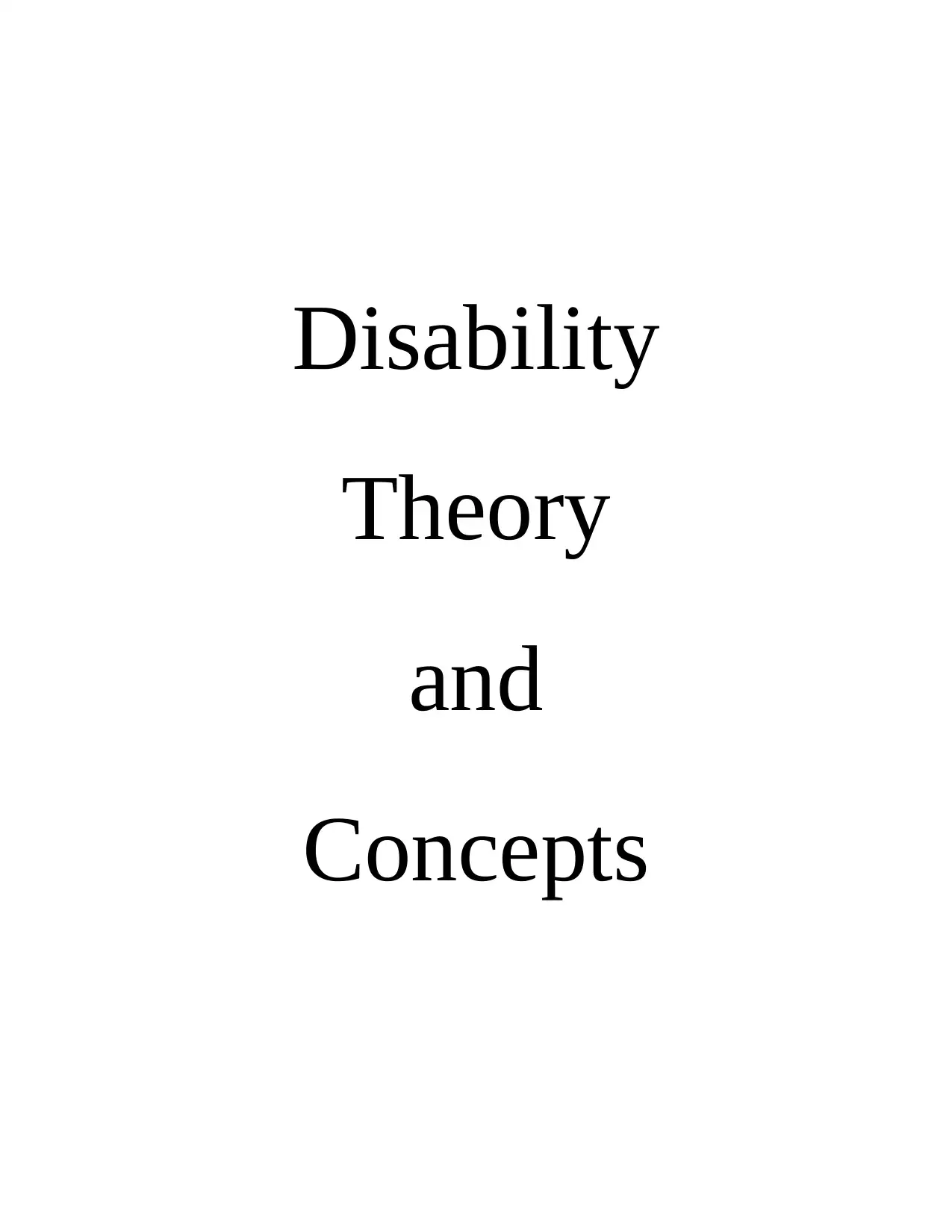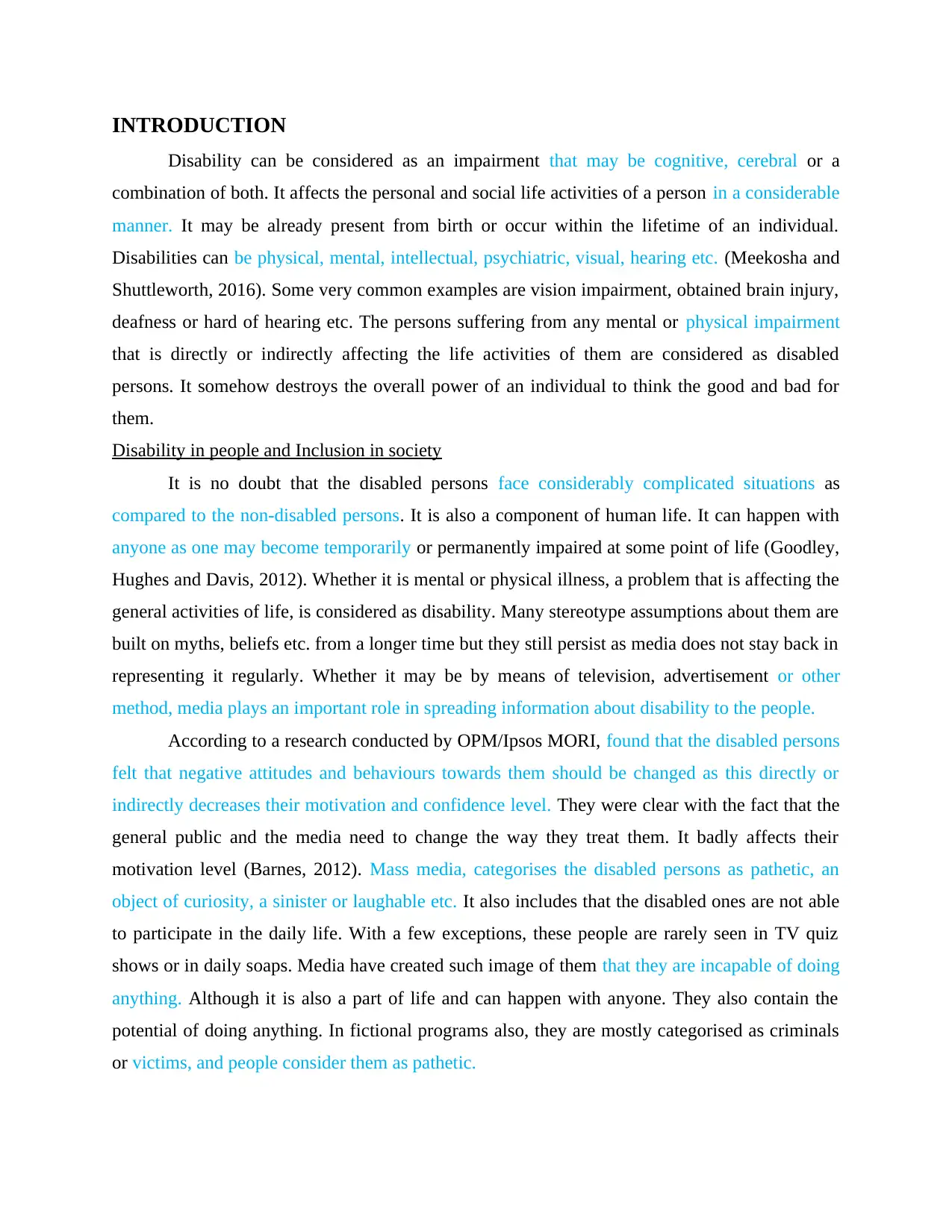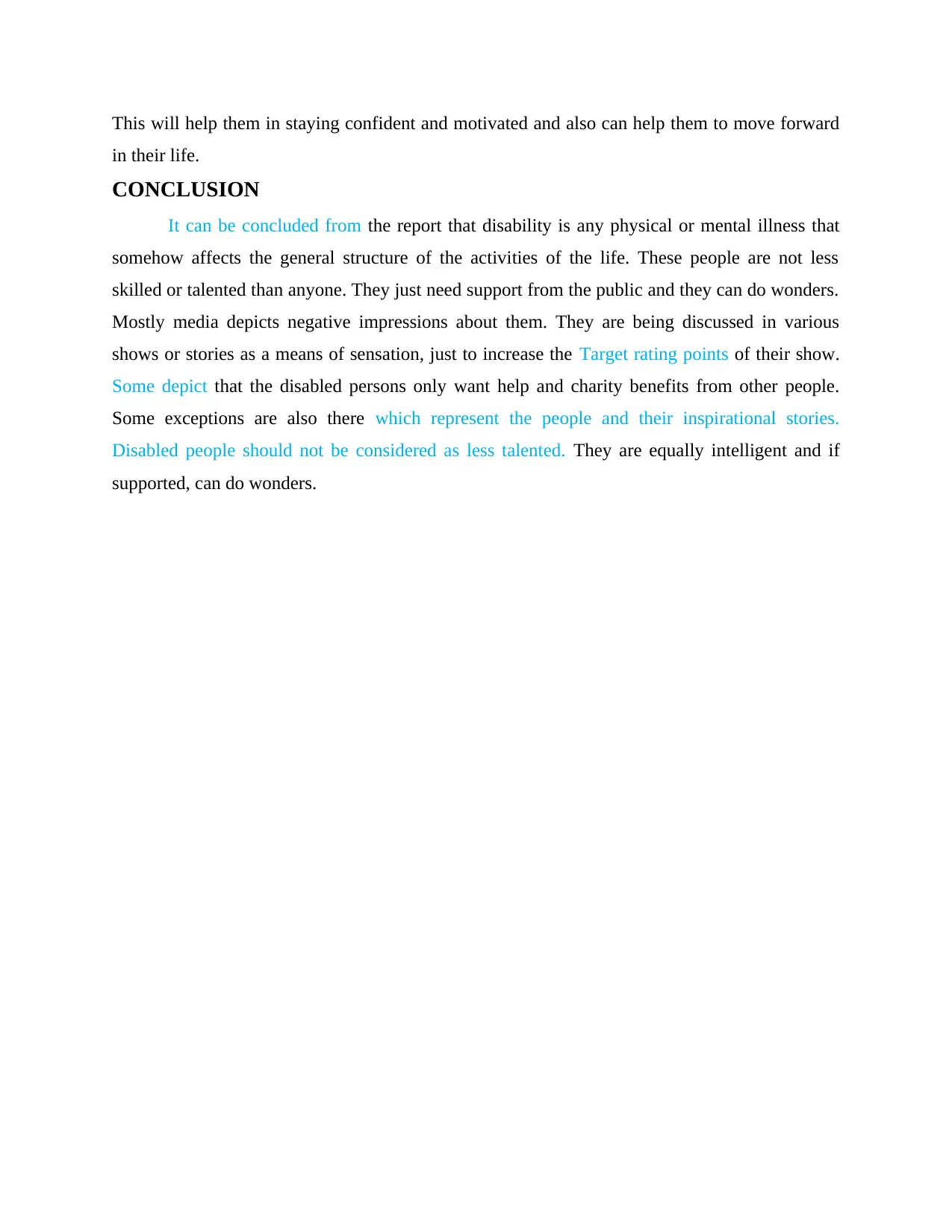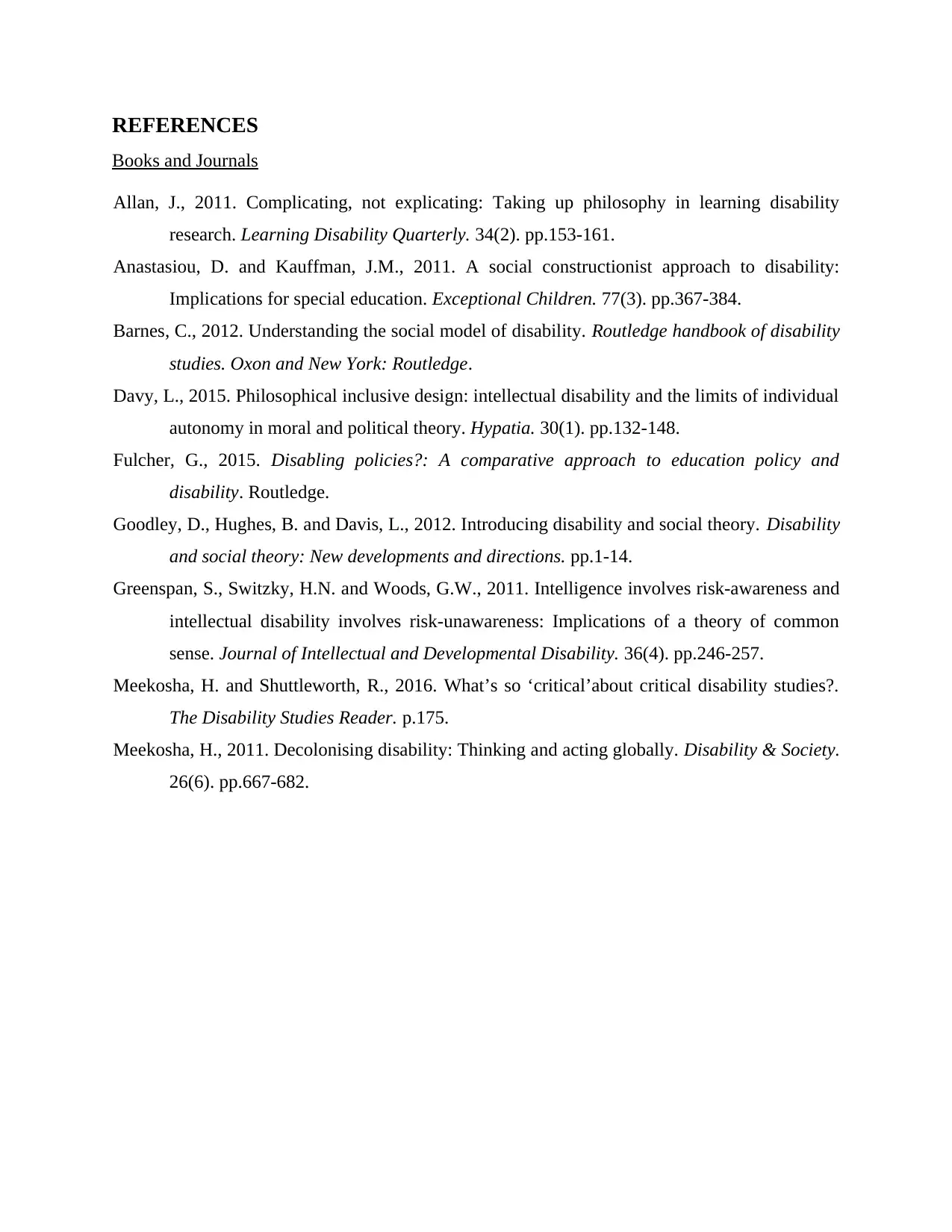Disability Theory and Concepts: Societal Inclusion and Media Portrayal
VerifiedAdded on 2020/07/23
|6
|1424
|127
Essay
AI Summary
This essay delves into the multifaceted realm of disability theory, exploring core concepts and their implications for societal inclusion. It examines how disability is conceptualized, considering both physical and mental impairments and their impact on individuals' lives. The essay critically analyzes the role of media in shaping public perceptions of disability, highlighting common stereotypes and negative portrayals that often marginalize disabled persons. It discusses the importance of changing attitudes and behaviors towards disabled individuals and advocates for more accurate and inclusive representations in media. The essay further explores the social model of disability, emphasizing how societal barriers and attitudes, rather than individual impairments, often create challenges for disabled people. It concludes by stressing the need for support from the general public and media to empower disabled persons, recognizing their potential and advocating for a more inclusive society.

Disability
Theory
and
Concepts
Theory
and
Concepts
Paraphrase This Document
Need a fresh take? Get an instant paraphrase of this document with our AI Paraphraser

TABLE OF CONTENTS
INTRODUCTION...........................................................................................................................3
Disability in people and Inclusion in society..............................................................................3
How media conceptualises the disability....................................................................................3
CONCLUSION................................................................................................................................5
REFERENCES................................................................................................................................6
INTRODUCTION...........................................................................................................................3
Disability in people and Inclusion in society..............................................................................3
How media conceptualises the disability....................................................................................3
CONCLUSION................................................................................................................................5
REFERENCES................................................................................................................................6

INTRODUCTION
Disability can be considered as an impairment that may be cognitive, cerebral or a
combination of both. It affects the personal and social life activities of a person in a considerable
manner. It may be already present from birth or occur within the lifetime of an individual.
Disabilities can be physical, mental, intellectual, psychiatric, visual, hearing etc. (Meekosha and
Shuttleworth, 2016). Some very common examples are vision impairment, obtained brain injury,
deafness or hard of hearing etc. The persons suffering from any mental or physical impairment
that is directly or indirectly affecting the life activities of them are considered as disabled
persons. It somehow destroys the overall power of an individual to think the good and bad for
them.
Disability in people and Inclusion in society
It is no doubt that the disabled persons face considerably complicated situations as
compared to the non-disabled persons. It is also a component of human life. It can happen with
anyone as one may become temporarily or permanently impaired at some point of life (Goodley,
Hughes and Davis, 2012). Whether it is mental or physical illness, a problem that is affecting the
general activities of life, is considered as disability. Many stereotype assumptions about them are
built on myths, beliefs etc. from a longer time but they still persist as media does not stay back in
representing it regularly. Whether it may be by means of television, advertisement or other
method, media plays an important role in spreading information about disability to the people.
According to a research conducted by OPM/Ipsos MORI, found that the disabled persons
felt that negative attitudes and behaviours towards them should be changed as this directly or
indirectly decreases their motivation and confidence level. They were clear with the fact that the
general public and the media need to change the way they treat them. It badly affects their
motivation level (Barnes, 2012). Mass media, categorises the disabled persons as pathetic, an
object of curiosity, a sinister or laughable etc. It also includes that the disabled ones are not able
to participate in the daily life. With a few exceptions, these people are rarely seen in TV quiz
shows or in daily soaps. Media have created such image of them that they are incapable of doing
anything. Although it is also a part of life and can happen with anyone. They also contain the
potential of doing anything. In fictional programs also, they are mostly categorised as criminals
or victims, and people consider them as pathetic.
Disability can be considered as an impairment that may be cognitive, cerebral or a
combination of both. It affects the personal and social life activities of a person in a considerable
manner. It may be already present from birth or occur within the lifetime of an individual.
Disabilities can be physical, mental, intellectual, psychiatric, visual, hearing etc. (Meekosha and
Shuttleworth, 2016). Some very common examples are vision impairment, obtained brain injury,
deafness or hard of hearing etc. The persons suffering from any mental or physical impairment
that is directly or indirectly affecting the life activities of them are considered as disabled
persons. It somehow destroys the overall power of an individual to think the good and bad for
them.
Disability in people and Inclusion in society
It is no doubt that the disabled persons face considerably complicated situations as
compared to the non-disabled persons. It is also a component of human life. It can happen with
anyone as one may become temporarily or permanently impaired at some point of life (Goodley,
Hughes and Davis, 2012). Whether it is mental or physical illness, a problem that is affecting the
general activities of life, is considered as disability. Many stereotype assumptions about them are
built on myths, beliefs etc. from a longer time but they still persist as media does not stay back in
representing it regularly. Whether it may be by means of television, advertisement or other
method, media plays an important role in spreading information about disability to the people.
According to a research conducted by OPM/Ipsos MORI, found that the disabled persons
felt that negative attitudes and behaviours towards them should be changed as this directly or
indirectly decreases their motivation and confidence level. They were clear with the fact that the
general public and the media need to change the way they treat them. It badly affects their
motivation level (Barnes, 2012). Mass media, categorises the disabled persons as pathetic, an
object of curiosity, a sinister or laughable etc. It also includes that the disabled ones are not able
to participate in the daily life. With a few exceptions, these people are rarely seen in TV quiz
shows or in daily soaps. Media have created such image of them that they are incapable of doing
anything. Although it is also a part of life and can happen with anyone. They also contain the
potential of doing anything. In fictional programs also, they are mostly categorised as criminals
or victims, and people consider them as pathetic.
⊘ This is a preview!⊘
Do you want full access?
Subscribe today to unlock all pages.

Trusted by 1+ million students worldwide

How media conceptualises the disability
The same way as being done in televisions, criticism on the bases of their disability is
also evident in newspapers. Use of disablist language is very common to them in the tabloids as
well as in the leading newspapers. Various reports in the newspapers feature disability not for
their accuracy, but for their sensation value. In the industry of advertisement, they generally
contribute to the discrimination in two ways. These people are excluded initially and in some
cases, are being totally ignored by these agencies or mainstream advertisers. Whether they are
newspapers or advertisements, they depict the disabled persons as losers. In charity
advertisement, depiction of these people acts as an important part of argument. It specially
affects these people and the specific organisation as well. Their reflection as pathetic is still a
common concern in advertisements of the charity.
The media perceives certain images of the persons disabled by covering some specific
areas and ignoring the others. It prolongs the stereotypes of disability by their portrayals of
characters. Although till now, there has been no evidence that the mass media has any strong
impact on manipulating the attitudes of the audience. People change their opinions and attitudes
as a result of what they listen or what they have seen. The mass media appears to create negative
impressions of the disabled persons (Davy, 2015). It is also strengthened by the capability of the
people to avoid the media in consideration to the other sources of penetrating the social reality.
The media is enough capable of implementing new knowledge and the overall contribution of the
views and ideas at a place they are not in any conflict with the powerfully held views.
Many media portrayals that are fictional and inaccurate produce the notions of disabilities
that are not appropriate at all. False depictions represent the wrong message and the positive ones
help in generating more opportunities and awareness for all the disabled people. Many TV shows
or stories depicts that the disabled persons are always desperate of need, help or charity. Serious
actions have also been taken against such shows which were depicting that all they want is
charity and help (Allan, 2011). It represents a disabled person as sick. In fact these persons are
courageous enough as they deal with this much criticism and hate also from some people. Some
articles also focus on inspirational stories of such persons. Although this kind of people are few
but still they depicts an inspirational and courageous story. Along with the disability, these
people are also talented and creative. All they need is the support from general public and media.
The same way as being done in televisions, criticism on the bases of their disability is
also evident in newspapers. Use of disablist language is very common to them in the tabloids as
well as in the leading newspapers. Various reports in the newspapers feature disability not for
their accuracy, but for their sensation value. In the industry of advertisement, they generally
contribute to the discrimination in two ways. These people are excluded initially and in some
cases, are being totally ignored by these agencies or mainstream advertisers. Whether they are
newspapers or advertisements, they depict the disabled persons as losers. In charity
advertisement, depiction of these people acts as an important part of argument. It specially
affects these people and the specific organisation as well. Their reflection as pathetic is still a
common concern in advertisements of the charity.
The media perceives certain images of the persons disabled by covering some specific
areas and ignoring the others. It prolongs the stereotypes of disability by their portrayals of
characters. Although till now, there has been no evidence that the mass media has any strong
impact on manipulating the attitudes of the audience. People change their opinions and attitudes
as a result of what they listen or what they have seen. The mass media appears to create negative
impressions of the disabled persons (Davy, 2015). It is also strengthened by the capability of the
people to avoid the media in consideration to the other sources of penetrating the social reality.
The media is enough capable of implementing new knowledge and the overall contribution of the
views and ideas at a place they are not in any conflict with the powerfully held views.
Many media portrayals that are fictional and inaccurate produce the notions of disabilities
that are not appropriate at all. False depictions represent the wrong message and the positive ones
help in generating more opportunities and awareness for all the disabled people. Many TV shows
or stories depicts that the disabled persons are always desperate of need, help or charity. Serious
actions have also been taken against such shows which were depicting that all they want is
charity and help (Allan, 2011). It represents a disabled person as sick. In fact these persons are
courageous enough as they deal with this much criticism and hate also from some people. Some
articles also focus on inspirational stories of such persons. Although this kind of people are few
but still they depicts an inspirational and courageous story. Along with the disability, these
people are also talented and creative. All they need is the support from general public and media.
Paraphrase This Document
Need a fresh take? Get an instant paraphrase of this document with our AI Paraphraser

This will help them in staying confident and motivated and also can help them to move forward
in their life.
CONCLUSION
It can be concluded from the report that disability is any physical or mental illness that
somehow affects the general structure of the activities of the life. These people are not less
skilled or talented than anyone. They just need support from the public and they can do wonders.
Mostly media depicts negative impressions about them. They are being discussed in various
shows or stories as a means of sensation, just to increase the Target rating points of their show.
Some depict that the disabled persons only want help and charity benefits from other people.
Some exceptions are also there which represent the people and their inspirational stories.
Disabled people should not be considered as less talented. They are equally intelligent and if
supported, can do wonders.
in their life.
CONCLUSION
It can be concluded from the report that disability is any physical or mental illness that
somehow affects the general structure of the activities of the life. These people are not less
skilled or talented than anyone. They just need support from the public and they can do wonders.
Mostly media depicts negative impressions about them. They are being discussed in various
shows or stories as a means of sensation, just to increase the Target rating points of their show.
Some depict that the disabled persons only want help and charity benefits from other people.
Some exceptions are also there which represent the people and their inspirational stories.
Disabled people should not be considered as less talented. They are equally intelligent and if
supported, can do wonders.

REFERENCES
Books and Journals
Allan, J., 2011. Complicating, not explicating: Taking up philosophy in learning disability
research. Learning Disability Quarterly. 34(2). pp.153-161.
Anastasiou, D. and Kauffman, J.M., 2011. A social constructionist approach to disability:
Implications for special education. Exceptional Children. 77(3). pp.367-384.
Barnes, C., 2012. Understanding the social model of disability. Routledge handbook of disability
studies. Oxon and New York: Routledge.
Davy, L., 2015. Philosophical inclusive design: intellectual disability and the limits of individual
autonomy in moral and political theory. Hypatia. 30(1). pp.132-148.
Fulcher, G., 2015. Disabling policies?: A comparative approach to education policy and
disability. Routledge.
Goodley, D., Hughes, B. and Davis, L., 2012. Introducing disability and social theory. Disability
and social theory: New developments and directions. pp.1-14.
Greenspan, S., Switzky, H.N. and Woods, G.W., 2011. Intelligence involves risk-awareness and
intellectual disability involves risk-unawareness: Implications of a theory of common
sense. Journal of Intellectual and Developmental Disability. 36(4). pp.246-257.
Meekosha, H. and Shuttleworth, R., 2016. What’s so ‘critical’about critical disability studies?.
The Disability Studies Reader. p.175.
Meekosha, H., 2011. Decolonising disability: Thinking and acting globally. Disability & Society.
26(6). pp.667-682.
Books and Journals
Allan, J., 2011. Complicating, not explicating: Taking up philosophy in learning disability
research. Learning Disability Quarterly. 34(2). pp.153-161.
Anastasiou, D. and Kauffman, J.M., 2011. A social constructionist approach to disability:
Implications for special education. Exceptional Children. 77(3). pp.367-384.
Barnes, C., 2012. Understanding the social model of disability. Routledge handbook of disability
studies. Oxon and New York: Routledge.
Davy, L., 2015. Philosophical inclusive design: intellectual disability and the limits of individual
autonomy in moral and political theory. Hypatia. 30(1). pp.132-148.
Fulcher, G., 2015. Disabling policies?: A comparative approach to education policy and
disability. Routledge.
Goodley, D., Hughes, B. and Davis, L., 2012. Introducing disability and social theory. Disability
and social theory: New developments and directions. pp.1-14.
Greenspan, S., Switzky, H.N. and Woods, G.W., 2011. Intelligence involves risk-awareness and
intellectual disability involves risk-unawareness: Implications of a theory of common
sense. Journal of Intellectual and Developmental Disability. 36(4). pp.246-257.
Meekosha, H. and Shuttleworth, R., 2016. What’s so ‘critical’about critical disability studies?.
The Disability Studies Reader. p.175.
Meekosha, H., 2011. Decolonising disability: Thinking and acting globally. Disability & Society.
26(6). pp.667-682.
⊘ This is a preview!⊘
Do you want full access?
Subscribe today to unlock all pages.

Trusted by 1+ million students worldwide
1 out of 6
Related Documents
Your All-in-One AI-Powered Toolkit for Academic Success.
+13062052269
info@desklib.com
Available 24*7 on WhatsApp / Email
![[object Object]](/_next/static/media/star-bottom.7253800d.svg)
Unlock your academic potential
Copyright © 2020–2026 A2Z Services. All Rights Reserved. Developed and managed by ZUCOL.




